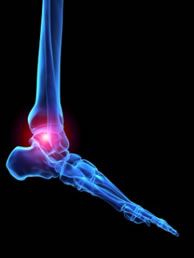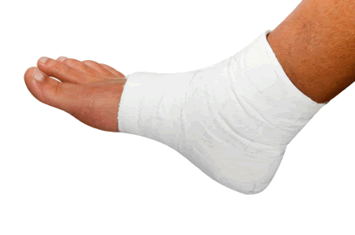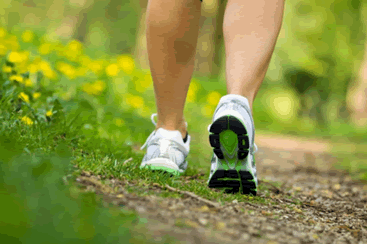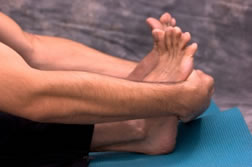
 (732) 246-1377
(732) 246-1377
 (732) 246-1377
(732) 246-1377 Arthritis is a disease that often causes those affected to go without exercise due to the pain. Nearly 44% of those with arthritis say they don’t exercise and nearly 88% say they are not nearly active enough. According to a controlled trial published in the Journal of Rheumatology, those with arthritis that practiced yoga at least three times a week had an improvement in pain, energy, mood, and physical health. According to Dr. Clifton O. Bingham III, associate professor of John Hopkins University, “It has really been transformative for a lot of my patients.” For some of Dr. Bingham’s patients, yoga has helped them through arthritis for over five years.
Arthritis is a disease that often causes those affected to go without exercise due to the pain. Nearly 44% of those with arthritis say they don’t exercise and nearly 88% say they are not nearly active enough. According to a controlled trial published in the Journal of Rheumatology, those with arthritis that practiced yoga at least three times a week had an improvement in pain, energy, mood, and physical health. According to Dr. Clifton O. Bingham III, associate professor of John Hopkins University, “It has really been transformative for a lot of my patients.” For some of Dr. Bingham’s patients, yoga has helped them through arthritis for over five years.
Arthritis can be a difficult condition to live with. If you are suffering from arthritic foot pain, contact Dr. Dave Poonai of Livingston Foot Care. Our podiatrist can treat your foot and ankle needs.
Arthritic Foot Care
Arthritis is a joint disorder that involves inflammation of different joints in your body, such as in your feet. Arthritis is often caused by a degenerative joint disease and causes mild to severe pain in all affected areas. On top of this, swelling and stiffness in the affected joints can also be a common symptom of arthritis.
In many cases, wearing ill-fitting shoes can worsen the effects and pain of arthritis. Wearing shoes that have a lower heel and extra room can help your feet feel more comfortable. In cases of rheumatoid arthritis, the arch in your foot may become problematic. Buying shoes with proper arch support that contour to your feet can help immensely.
Alleviating Arthritic Pain
· Exercises that stretch the foot can prevent further pain and injury and increase mobility
· Most of the pain can be alleviated with anti-inflammatory drugs, heat, and topical medications
· Massages can help to temporarily alleviate pain.
It is best to see your doctor for the treatment that is right for your needs and symptoms. Conditions vary, and a podiatrist can help you determine the right method of care for your feet.
If you have any questions about arthritic foot care, please feel free to contact our office located in North Brunswick, NJ. We offer the newest diagnostic and treatment technologies for all your foot and ankle needs.
 Fernando Gago of Boca Juniors has confirmed a partial rupture in his left Achilles tendon. According to specialist Jorge Batista of La Trinidad Clinic, Gago will have to miss the rest of the season after surgery. This injury will rule him out of Argentina’s World Cup Qualifiers against Ecuador and Paraguay in the next couple of months. Batista suggests that Gago will be out for four to six months.
Fernando Gago of Boca Juniors has confirmed a partial rupture in his left Achilles tendon. According to specialist Jorge Batista of La Trinidad Clinic, Gago will have to miss the rest of the season after surgery. This injury will rule him out of Argentina’s World Cup Qualifiers against Ecuador and Paraguay in the next couple of months. Batista suggests that Gago will be out for four to six months.
Achilles tendon injuries need immediate attention to avoid future complications. If you have any concerns about your feet or ankles, contact Dr. Dave Poonai of Livingston Podiatry. Our doctor will treat your foot and ankle needs.
What is the Achilles Tendon?
The Achilles tendon is a tendon that connects the lower leg muscles and calf to the heel of the foot. It is the strongest tendon in the human body and is essential for making movement possible. Because this tendon is such an integral part of the body, any injuries to it can cause severe difficulties and should immediately be presented to a doctor.
What are the symptoms of an Achilles Tendon Injury?
There are various types of injuries that can affect the Achilles tendon. The two most common are Achilles tendinitis and ruptures of the tendon.
Achilles Tendinitis Symptoms
- Inflammation
- Dull to Severe Pain
- Increased blood flow to the tendon
- Thickening of the tendon
Rupture Symptoms
- Extreme pain and swelling in the foot
- Total immobility
Treatment and Prevention
Achilles tendon injuries are diagnosed by a thorough physical evaluation, which can include an MRI. Treatment involves rest, physical therapy, and in some cases, surgery. However, various preventative measures can be taken to avoid these injuries, such as:
- Thorough stretching of the tendon before and after exercise
- Strengthening exercises like calf raises, squats, leg curls, leg extensions, leg raises, lunges, and leg presses
If you have any questions please feel free to contact our office located in North Brunswick, NY. We offer the newest diagnostic tools and technology to treat your foot and ankle needs.
 In the past couple of years, the running shoe market has skyrocketed with nearly thirty-five legitimate running shoe models currently for sale in the United States this year. Experts claim this may be occurring because we live in a fitness conscious society where there is high appeal for running shoes. Since running has become a more accessible form of exercise more people than ever before are interested in purchasing the proper shoe for their foot type.
In the past couple of years, the running shoe market has skyrocketed with nearly thirty-five legitimate running shoe models currently for sale in the United States this year. Experts claim this may be occurring because we live in a fitness conscious society where there is high appeal for running shoes. Since running has become a more accessible form of exercise more people than ever before are interested in purchasing the proper shoe for their foot type.
The right running shoe is essentially different for every person. If you have any concerns feel free to contact Dr. David Poonai of New Jersey. Our doctor will treat your foot and ankle needs.
Choosing the Right Running Shoes for Your Foot Type
Running is a physical activity although fun, can put a lot of stress on the joints, bones and ligaments of the body. Injury and stress on the foot can be an important factor on which kind of shoe you’re wearing. Running shoes should be worn based on your foot type. It is important to find out what fits you based on cushioning, stability and motion.
Determining your type
Speak with a shoe specialist or retail professional to see what your foot type is. They will be able to identify and measure your arch type, stride and gait.
Running Mechanics
When you are running or walking in your shoes, every step determines how your foot is landing. Pronation is the natural rolling of your ankle from outside to inside during foot strike.
Pronation is a correct form of walking or running. It helps absorb shock and store energy from your lower extremities. Neutral runners who pronate correctly do not need specific shoes, since they have stability and control.
Over-pronators
Those who run with excessive ankle rolling. Over-pronators tend to have ankles that angle inward, flat feet, and or bowed legs. This can cause a series of injuries: of the knees, ankles and Achilles tendons.
Under-pronation
Under-pronation is less common than over-pronation. This usually happens to those who have inflexible feet and high arches. Even though there is less rotational stress on the ankles and knees, it prevents any kind of shock absorptions. Under-pronation needs shoes with increase in cushion and flexibility.
If you have any questions please feel free to contact our office located in New Brunswick, NJ. We offer the newest diagnostic tools and technology to treat your foot and ankle needs.
 While running is a great exercise to help the body, the feet need their own form of exercise to maintain stability and strength for the body. Exercising the arch, toes, and legs regularly can better your full body routine as well as help preventing injury. The big toe press, pressing your big toe on the floor while reaching with your four other toes in an eight second hold can help strengthen the arch of the foot. Moving the toes away from each other without curling or extending them in a toe splay can be practiced throughout the day for foot strengthening. Calf raises and leg swings can be performed 15 times daily to regulate foot strength.
While running is a great exercise to help the body, the feet need their own form of exercise to maintain stability and strength for the body. Exercising the arch, toes, and legs regularly can better your full body routine as well as help preventing injury. The big toe press, pressing your big toe on the floor while reaching with your four other toes in an eight second hold can help strengthen the arch of the foot. Moving the toes away from each other without curling or extending them in a toe splay can be practiced throughout the day for foot strengthening. Calf raises and leg swings can be performed 15 times daily to regulate foot strength.
Exercising your feet regularly with the proper foot wear is a great way to prevent injuries. If you have any concerns about your feet contact Dr. Poonai of New Brunswick. Our doctor will treat your foot and ankle needs.
Exercise for Your Feet
Exercise for your feet can help you to gain strength, mobility and flexibility in your feet. They say that strengthening your feet can be just as rewarding as strengthening another part of the body. Your feet are very important and often we forget about them in our daily tasks. But it is because of our feet that are we able to get going and do what we need to. For those of us fortunate not to have any foot problems, it is an important gesture to take care of them to ensure its good health in the long run.
Some foot health exercises can include ankle pumps, tip-toeing, toe rise, lifting off the floor doing reps and sets, also flexing the toes and involving the shins may help too. It is best to speak with your doctor regarding how to do these fitness steps and how often is right for you. Everyone’s needs and bodies are different and it varies from individual to individual to determine what should be done for you to maintain strength in your feet.
Once you get into a routine of doing regular exercise, you may notice a difference in your feet and how strong they may become.
If you have any questions, please feel free to contact our office located in New Brunswick, NJ. We offer the newest diagnostic tools and technologies to treat your foot and ankle needs.
 Robert P. Thompson, executive director of non-profit Institute of Preventative Foot Health recently spoke at the American Association of Diabetics Ecuador Annual Meeting 2015 where he stressed the importance of diabetic foot checkups. Thompson stated that medical professionals should do routine checkups on diabetic feet every visit and patients suffering from diabetes should keep an eye on their own feet twice a day. Regular foot checks are a major component of diabetes management where reducing the odds of neuropathy, inability to feel pain, slow wound healing, infection, ulcers, and amputation are reduced.
Robert P. Thompson, executive director of non-profit Institute of Preventative Foot Health recently spoke at the American Association of Diabetics Ecuador Annual Meeting 2015 where he stressed the importance of diabetic foot checkups. Thompson stated that medical professionals should do routine checkups on diabetic feet every visit and patients suffering from diabetes should keep an eye on their own feet twice a day. Regular foot checks are a major component of diabetes management where reducing the odds of neuropathy, inability to feel pain, slow wound healing, infection, ulcers, and amputation are reduced. If you are suffering from diabetes or have any other concerns about your feet, contact Dr. Poonai of New Jersey. Our doctor will diagnose and treat your foot and ankle needs.
Diabetic Foot Care
Diabetes affects millions of people every year. Diabetes can damage blood vessels in many parts of the body, including the feet. Because of this, taking care of your feet is essential if you have diabetes, and having a podiatrist help monitor your foot health is highly recommended.
The Importance of Caring for Your Feet
· Routinely inspect your feet for bruises or sores.
· Wear socks that fit your feet comfortably.
· Wear comfortable shoes that provide adequate support.
Patients with diabetes should have their doctor monitor their blood levels because blood sugar levels play such a huge role in diabetic care. Monitoring these levels on a regular basis is highly advised.
It is always best to inform your healthcare professional of any concerns you may have regarding your feet, especially for diabetic patients. Early treatment and routine foot examinations are keys to maintaining proper health, especially because severe complications can arise if proper treatment is not applied.
If you have any questions, please feel free to contact our office in New Brunswick, NJ. We offer the newest diagnostic and treatment technologies for all your foot and ankle needs.
 The American Podiatric Medical Association recently published a study revealing that much of this nation’s foot pain goes untreated. In a survey of 1,000 people over the age of 18, 77% reported experiencing foot pain, but only a third of those claim they would see a podiatrist. Half of the participants with foot pain say that the pain has hindered walking, exercising, playing with grandchildren, and other daily activities.
The American Podiatric Medical Association recently published a study revealing that much of this nation’s foot pain goes untreated. In a survey of 1,000 people over the age of 18, 77% reported experiencing foot pain, but only a third of those claim they would see a podiatrist. Half of the participants with foot pain say that the pain has hindered walking, exercising, playing with grandchildren, and other daily activities.
Among the group who sought podiatric help, 88% reported a quick diagnosis and 76% received treatment that eliminated the problem. A third of the group said that their visits to the podiatrist exposed other health concerns, such as diabetes, circulatory issues, and nerve issues.
"It's not surprising to see how many people are affected by foot pain, when survey results show that we view our feet as the least important body part in terms of our overall health and wellbeing," said AMPA President Frank Spinosa. "Our feet are literally and figuratively the furthest things from our minds."
If you are experiencing pain in the feet or ankles, don’t join the stubborn majority refusing treatment. Seek the assistance of Dr. Dave Poonai of New Jersey. Our doctor will provide the care you need to keep you pain free and on your feet.
What is a Podiatrist?
Someone would seek care of a podiatrist when they have suffered a foot injury or have common foot ailments such as: heal spurs, bunions, arch problems, deformities, ingrown toenails, corns, foot and ankle problems etc.
Podiatric Treatment
A podiatrist will treat the problematic areas of the feet, ankle or lower leg by prescribing the following:
physical therapy
drugs
perform surgery on lower extremity fractures
orthotic inserts or soles
A common podiatric procedure a podiatrist will use is a scanner or force plate which will allow the podiatrist to know the designs of orthotics. Patients are then told to follow a series of tasks to complete the treatment. The computer will scan the foot a see which areas show weight distribution and pressure points. The podiatrist will read the analysis and then determine which treatment plans are available.
For more information about Podiatrists, follow the link below.
If you have any questions, please feel free to contact our office located in North Brunswick, NJ. We offer the newest diagnostic and treatment technologies for all your foot and ankle needs.